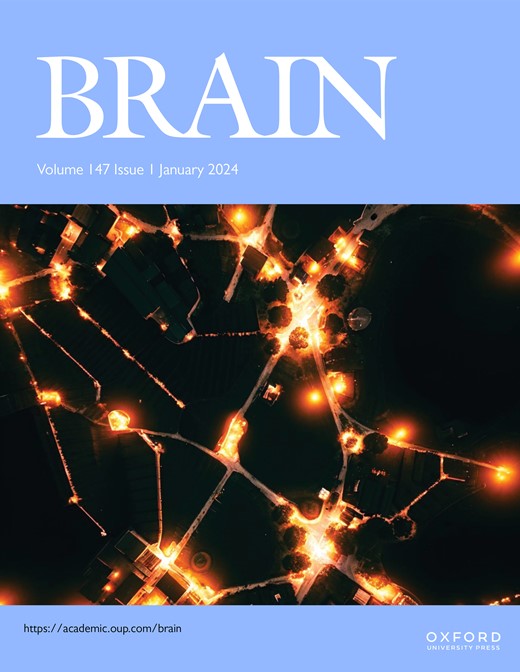双叶 EPB41L3 变异是一种伴有癫痫发作和髓鞘缺损的发育障碍的基础
IF 10.6
1区 医学
Q1 CLINICAL NEUROLOGY
引用次数: 0
摘要
红细胞膜蛋白带 4.1 Like 3(EPB41L3: NM_012307.5)又称 DAL-1,编码普遍表达的、富含神经元的 4.1B 蛋白,是 4.1 超家族膜-骨架适配体的一部分。4.1B 在细胞扩散、迁移和细胞骨架支架中发挥着关键作用,而细胞骨架支架支持着正常髓鞘化所必需的少突胶质细胞轴突粘附。我们在本文中描述了来自五个非亲缘家庭的六名患者,他们患有全面发育迟缓、智力障碍、癫痫发作、肌张力低下、神经退化和髓鞘化延迟。外显子组测序确定了所有受影响个体中 EPB41L3 的双倍变异:两个无义变异(c.466C>T, p.(R156*); c.2776c.666delT,p.(F222Lfs*46);c.2289dupC,p.(V764Rfs*19);c.948_949delTG,p.(A317Kfs*33))。在携带 EPB41L3:c.666delT, p.(F222Lfs*46) 的人成纤维细胞中进行的定量实时 PCR 和 Western 印迹分析表明,EPB41L3 mRNA 和 4.1B 蛋白表达被消减。抑制无义介导衰变(NMD)途径会导致 EPB41L3:c.666delT 转录本上调,从而支持 NMD 是一种致病机制。Epb41l3缺陷的小鼠少突胶质细胞显示关键髓鞘基因的mRNA表达显著减少,分支减少,凋亡增加。我们的报告首次在临床上描述了一种与 EPB41L3 变异相关的常染色体隐性遗传疾病,我们称之为 EPB41L3 相关发育障碍(EADD)。此外,我们的功能研究证实了 EPB41L3 假设功能缺失变体的致病性。本文章由计算机程序翻译,如有差异,请以英文原文为准。
Biallelic EPB41L3 variants underlie a developmental disorder with seizures and myelination defects
Erythrocyte Membrane Protein Band 4.1 Like 3 (EPB41L3: NM_012307.5), also known as DAL-1, encodes the ubiquitously expressed, neuronally enriched 4.1B protein, part of the 4.1 superfamily of membrane-cytoskeleton adaptors. 4.1B plays key roles in cell spreading, migration, and cytoskeletal scaffolding that support oligodendrocyte axon adhesions essential for proper myelination. We herein describe six individuals from five unrelated families with global developmental delay, intellectual disability, seizures, hypotonia, neuroregression, and delayed myelination. Exome sequencing identified biallelic variants in EPB41L3 in all affected individuals: two nonsense (c.466C>T, p.(R156*); c.2776C>T, p.(R926*)) and three frameshift (c.666delT, p.(F222Lfs*46); c.2289dupC, p.(V764Rfs*19); c.948_949delTG, p.(A317Kfs*33)). Quantitative-real time PCR and Western blot analysis in human fibroblasts harbouring EPB41L3:c.666delT, p.(F222Lfs*46) indicate ablation of EPB41L3 mRNA and 4.1B protein expression. Inhibition of the nonsense mediated decay (NMD) pathway led to an upregulation of EPB41L3:c.666delT transcripts, supporting NMD as a pathogenic mechanism. Epb41l3-deficient mouse oligodendroglia cells showed significant reduction in mRNA expression of key myelin genes, reduced branching, and increased apoptosis. Our report provides the first clinical description of an autosomal recessive disorder associated with variants in EPB41L3, which we refer to as EPB41L3-associated developmental disorder (EADD). Moreover, our functional studies substantiate the pathogenicity of EPB41L3 hypothesized loss-of-function variants.
求助全文
通过发布文献求助,成功后即可免费获取论文全文。
去求助
来源期刊

Brain
医学-临床神经学
CiteScore
20.30
自引率
4.10%
发文量
458
审稿时长
3-6 weeks
期刊介绍:
Brain, a journal focused on clinical neurology and translational neuroscience, has been publishing landmark papers since 1878. The journal aims to expand its scope by including studies that shed light on disease mechanisms and conducting innovative clinical trials for brain disorders. With a wide range of topics covered, the Editorial Board represents the international readership and diverse coverage of the journal. Accepted articles are promptly posted online, typically within a few weeks of acceptance. As of 2022, Brain holds an impressive impact factor of 14.5, according to the Journal Citation Reports.
 求助内容:
求助内容: 应助结果提醒方式:
应助结果提醒方式:


